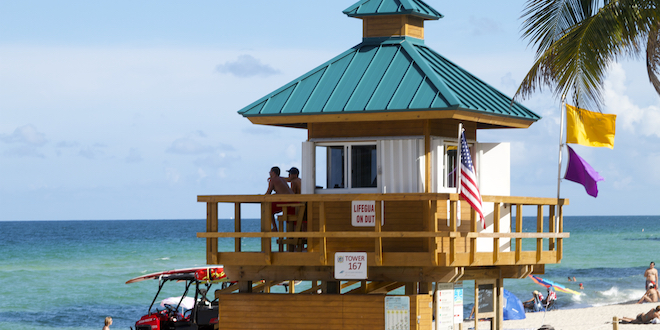By Justin Broman, Ocean Rescue Supervisor
Swimming is one of the most popular activities in South Florida. We have perfect water temperatures, hot sunny days, and numerous types of water sports to participate in. But there are some hidden dangers of which you should be aware. The Sunny Isles Beach Ocean Rescue Division is always taking extra steps to make sure our beach is a safe place for you and your family to spend the day. Sunny Isles Beach Lifeguards are continuously training to provide excellent service for our residents and visiting guests.
Beach Safety Tips
- Always swim in a guarded area.
- Check warning flags daily and ask a lifeguard about the surf and beach conditions. Did you know we post the daily warning flag update, including high tide and low tide, air and water temperature, wind direction and speed, and UV Index, each day on our webpage?
- Do not overestimate your swimming abilities, stay close to shore.
- Alcohol and swimming do not mix, swim sober.
- Do not dive or jump into unknown waters
- Always drink a lot of fluids (water) to stay hydrated.
- No glass containers are allowed on the beach, broken glass is an unseen hazard.
- Report all hazardous conditions to lifeguards.
- Always protect yourself from the sun with sunscreen, SPF 15 or higher.
- If you are in trouble, call or wave for help.
- If you are on a body board or surfboard, use a leash to keep the board close to you.
- Report all bird or animal injuries to a lifeguard, we try to save everything.
- If you are caught in a “Rip Current” the most important thing is: do not panic. Try to signal for help and swim parallel to shore or until the current releases you.
Rip Currents
A rip current is a seaward moving current that circulates water back to the sea from waves on the shoreline; a rip current is formed by pressured water. As the pressured water moves out to sea, it takes the path of least resistance, usually between sandbars and next to jetties and piers. When you arrive at the beach, check with the lifeguards and see which warning flag they are flying. Always swim near a lifeguard tower and obey their whistle as we are there to prevent anything from happening.
Rip currents can be very wide or narrow and they start pulling outwards very close to the shoreline. If you feel yourself getting pulled out by a rip current, DO NOT PANIC! Relax your body and breathing and look around for signs of current change. Do not try to fight it and swim directly back to shore. Swim parallel (North or South) and once you’re out of the current, start to make your way back to shore. If you get tired REMEMBER to relax, and you can float on your back just letting it pull you out. This will conserve your energy to yell and wave for help. This is why swimming in the area of lifeguard towers really makes a difference.
Signs of a Rip Current
• Seaweed or debris moves outward in a stream.
• A difference in water color.
• Waves not breaking, or churning water.
• Surface foam moving outward.
• Darker, deeper water areas
The Ocean Rescue Division is now part of the SIB Police Department and has recently increased its number of lifeguards and towers. This makes it very safe for you and your family in the case of an emergency. Also, remember that lifeguards are there for anything else you may need; so don’t be shy, walk by the tower and say “Hi.”
Beach Warning Flag Colors
Double Red – Water CLOSED to public
Red – High Hazard High Surf and/or Strong Currents
Yellow – Medium Hazard Moderate Surf and/or Currents
Green – Low Hazard Calm Conditions, Exercise Caution
Purple – Dangerous Marine Life
 City of Sunny Isles Beach Official Website
City of Sunny Isles Beach Official Website
